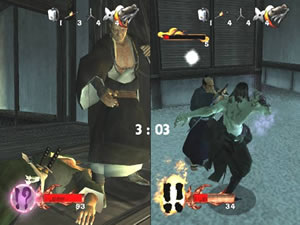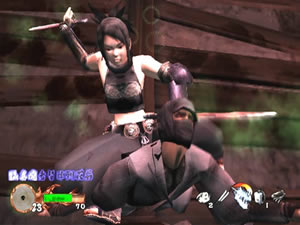Killing me softly.
So you’ve waited three years to don your grade-school ninja costume and sit
in front of your tube for some one-hit stealth killage, yet the $50 drop in
the bucket has you here with us reading fervently in an attempt to glean your
best course of action. Lucky for you that’s our job.
Activision’s Tenchu: Wrath of Heaven will sit well with most fans of
the original. It’s nearly twice as
long as the PSX masterpiece (26 total levels), it looks great and the gameplay
is straightforward. This iteration also includes a crude yet entertaining multiplayer
mode to carve up and heap on some extended playtime and replayability.
But
the wrath of a game reviewer can be vicious, and Tenchu‘s disjointed
mission structure, temperamental camera and disappointing enemy AI will leave
new gamers looking for something a bit more polished and sophisticated.
The story doesn’t lend itself much praise; it’s confusing at best. Like in
past Tenchu games, you reprise your role as either the strong Rikimaru
or the swift Ayame. Each has a specific 10-mission campaign. Unfortunately,
there is little variation between each characters’ Story mode.
The time is feudal Japan, and Rikimaru and Ayame are hot on the trail of a
new set of baddies. I’d tell more if I knew myself. There’s a lot to be said
for professional storywriters.
Much of the confusion has to do with the disjointed mission structure. You
just hop from mission to mission one after the other with very little in between
to tie it all together. This is the one area of Tenchu I thought would
be a shoo-in for an overhaul, yet it seems like the bland, sequential mission
layout has again won the day.
But this isn’t a deal breaker, because Riki and sweet little Ayame have quite
the repertoire of combos and stealth kills. Much of the game is spent running
around dark, expansive maps in search of the one guy who needs to become a kabob
on your blade. Crouching and placing your back against the wall are old-hat
favorites, though unfortunately don’t hold a candle to Sam
Fisher‘s impressive array of sly and sneaky moves. So instead, Tenchu
gives the player a wide variety of weapons and gadgets like crude grenades,
poison rice balls, spikes and a myriad of magical items.
Tenchu‘s emphasis is on stealth, which is where the game shines. Catch
any NPC unaware, and if you’re close enough you can perform a pre-scripted “stealth
kill.” Both Rikimaru and Ayame have several different stealth kills at their
disposal, and most are pretty damn cool. To aid you in this is your ‘sixth sense’
stealth meter, which changes color depending on your proximity to NPCs and their
level of awareness to you. Tread in heavy-footed and all enemies in your immediate
area will converge on your location like’well, samurai on a ninja. However,
you always have your trusty grappling hook, which can pull you out of a nasty
situation in mere seconds. Just point to an edge and let it fly. Tackling more
than one guy under the cover of stealth is a long, arduous task.
 In
In
addition to its gameplay impact, the grappling hook can get you high above the
enemy rabble where you can take in a better lay of the land. While the colors
are muted and drab, it fits the atmosphere perfectly for playing it sly and
sneaky. The textures hold up very well no matter how close you get to them.
Each map is cut up very realistically, featuring houses of various shapes and
sizes, small ponds with bridges and house workers and staff going about their
daily duties (which is merely to walk a prescribed path back and forth). Rikimaru
and Ayame are well modeled and detailed, and many old faces make a welcome return
with new costumes designs for the PS2. It’s a nice graphical engine and serves
the gameplay well.
I just wish the control was as pleasing. It’s not terribly difficult, but
the camera has a mind of its own, and, yet again, our main characters are not
very quick on the 180-degree spin. You do get a few cool back flips and turnaround
cartwheels, but how about the ability to just turn around quicker than a Mack
truck?
As I mentioned before, taking on a small horde of samurai is an exercise in
tedium. But don’t sweat it – just toss that trusty grappling hook and get the
hell out of Dodge, wait for a few long seconds and then the dummy NPCs will
return to their posts and patrols. Now you can try the stealth thing all over
again. I’m the hassasin…so
why is it these guys have such terrible short term memories? Well, at least
they bob around and dodge projectiles appropriately when in the heat of battle.
New to the Tenchu franchise is a welcomed multiplayer mode that pumps
some extended life into the game. Via split screen, you can play head-to-head
against a friend, which is pretty nifty. Just watch out for NPCs who may join
the fray to make things a little more interesting. Alternately, you can play
specific, shorter multiplayer missions co-op. Trying to coordinate your stealth
and location with a buddy is good fun. The downfall to the multiplayer is that
maps and missions are even more disjointed and act as simple one-shot deals
as opposed to a full-blown cooperative campaign.
Nonetheless, this addition is met with open arms and shows that someone back
at the lab is actually capable of making a move forward instead of a lateral
next-gen step, which is really what Tenchu: Wrath of Heaven brings to
the table. It’s serves up some good ninja fun, yet it doesn’t meet the challenge
brought forth by the Metal Gears and the
Splinter Cells.

-
Solid graphics
-
Good ninja action
-
Stealth kills rock
-
Multiplayer!
-
Feels old
-
Sad, disjointed mission structure
-
Camera issues
-
PSX caliber AI










